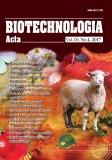ISSN 410-7751 (Print)
ISSN 2410-776X (on-line)

"Biotechnologia Acta" V. 10, No 4, 2017
https://doi.org/10.15407/biotech10.04.059
Р. 59-67, Bibliography 18, English
Universal Decimal Classification: 632.936:631.466
SYNTHESIS OF AROMA COMPOUNDS BY Pleurotus ostreatus (Jacq.:Fr.) Kumm. CULTURED ON VARIOUS SUBSTRATES
E. N. Vlasenko, J. V. Stepnevskaya, O. V. Kuznetsova
Kuznetsovakrainian State University of Chemical Technology, Dnipro, Ukraine
The aim of the study was to determine the intensity of synthesis of volatile aroma compounds by Pleurotus ostreatus (oyster mushroom) on sunflower husks and barley straw using sensory profile analysis and UV spectroscopy. The main cultural and morphological characteristics of the mycelial growth and development of fruiting bodies are determined: the period of mycelial development on the substrate, the time of primordial formation, the number of mushroom bunches per unit volume of substrate, the morphology of carpophores. Characteristic attributes of the aroma of dried fruiting bodies (mushroom, woody, sweet, herbaceous, fish, meat, floral, earthy, acidic, putrescent) are established and their aroma profiles are built. Sensory profile analysis of flavor of dried samples showed that the mushroom flavor of fungi cultivated on the sunflower husk is more pronounced than of those grown on barley straw. The light absorption maxima are recorded in the ranges 204–210 and 250–290 nm according to UV absorption spectra. Optimal conditions for extracting aromatics from dried fungi samples are the extraction time of 20–35 min at the boiling point of the solvent. Analysis of the UV spectra of fungal alcohol and hexane extracts showed that the intensity of the synthesis of volatile compounds is higher for strains cultivated on sunflower husks than for samples obtained on barley straw.
Key words: Pleurotus ostreatus, volatile aroma compounds, sensory profile analysis, UV spectroscopy.
© Palladin Institute of Biochemistry of National Academy of Sciences of Ukraine, 2017
References
1. Cho I.H., Namgung H.-J., Choi H.-K., Kim Y.-S. Volatiles and key odorants in the pileus and stipe of pine-mushroom (Tricholoma matsutake Sing.). Food Chem. 2008, V. 106, P. 71–76.
2. Cuevas-Glory L.F., Pino J.A., Santiago L.S., Sauri-Duch E. A review of volatile analytical methods for determiningthe botanical origin of honey. Food Chem. 2007, V. 103, P. 1032–1043. https://doi.org/10.1016/j.foodchem.2006.07.068
3. Miyazawa M., Usami A. Character impact odorants from mushrooms [Pleurotus citrinopileatus, Pleurotus eryngii var. ferulae, Lactarius hatsudake, and Hericium erinaceus (Bull.: Fr.) Pers.] used in Japanese traditional food. Nagoya Gaknin University. 2014, 50 (2), 1–24.
4. Combet E., Henderson J., Eastwood D.C., Burton K.S. Eight-carbon volatiles in mushrooms and fungi: properties, analysis, and biosynthesis. Mycoscience. 2006, V. 47, P. 317–326. https://doi.org/10.1007/S10267-006-0318-4
5. Wu S., Zorn H., Krings U., Berger R. G. Characteristic volatiles from young and aged fruiting bodies of wild Polyporus sulfurous (Bull.:Fr.) Fr. J. Agric. Food Chem. 2005, 53 (11), 4524–4528. https://doi.org/10.1021/jf0478511
6. Morath S.U., Hung R., Bennet J.W. Fungal volatile organic compounds: a review with emphasis on their biotechnological potential. Fung. Biol. Rev. 2012, V. 26, P. 73–83. https://doi.org/10.1016/j.fbr.2012.07.001
7. Nyegue M., Zollo P.-H.A., Bessiere J.-M., Rapior S. Volatile components of fresh Pleurotus ostreatus and Termitomyces shimperi from Cameroon. J. essential oil bearing plants. 2003, 6 (3), 153–160. https://doi.org/10.1080/0972-060X.2003.10643344
8. Zawirska-Wojtasiak R., Siwulski M., Mildner-Szkudlarz S., Wasowicz E. Studies on the aroma of different species and strains of Pleurotus measured by GH/MS, sensory analysis and electronic nose. Acta Sci. Pol. 2009, 8 (1), 47–61.
9. PubChem Compound Database. Available at: https://pubchem.ncbi.nlm.nih.gov (accessed 15 April 2017).
10. Jelen H.H., Majcher M. Food aroma compounds: tools and techniques for detection. Food Engin. Ingredients. 2009, P. 38–41.
11. Pisarev D.I., Novikov O.O. Methods for the isolation and analysis of essential oils. Nauchnye vedomosti Belgorodskogo gosudarstvennogo universiteta. Serija: Medicina. Farmacija. 2012, 10 (129), 25–30. (In Russian).
12. Jakimova L.S. Method of UV spectroscopy and its application in organic and physical chemistry. Kazan': Kazan. un-t. 2015, 19 p. (In Russian).
13. Rodina T.G. Sensory analysis of food products. Moskva: Akademija. 2004, 208 p. (In Russian).
14. Buhalo A.S., Bis'ko N.A., Solomko E.F., Poedinok N.L., Mihajlova O.B. The cultivation of edible and medicinal mushrooms. Кyiv: Chernobyl'interinform. 2004, 127 p. (In Russian).
15. Vlasenko K.M., Kuznecova O.V. The use of sensory analysis in biotechnology of the cultivation of macromycetes. Visn. Dnipropetr. Univ. Ser. Biol. Ekol. 2016, 24 (2), 347–352. https://doi.org/10.15421/011645 (In Ukrainian).
16. Simonjan A.V., Salamatov A.A., Pokrovskaja Ju.S., Avanesjan A.A. The use of ninhydrin reaction for the quantitative determination of ?-amino acids in various sites: Methodological recommendations. Volgograd. 2007, 106 p. (In Russian).
17. Atramentova L.O., Utevs'ka O.M. Statistics for biologists. Harkіv: Vidavnictvo «NTMT». 2014, 331 p. (In Ukrainian).
18. Sil'verstejn R., Bassler G., Morril T. Spectrometric identification of organic compounds. Moskva: Mir. 1977, 590 p. (In Russian).

